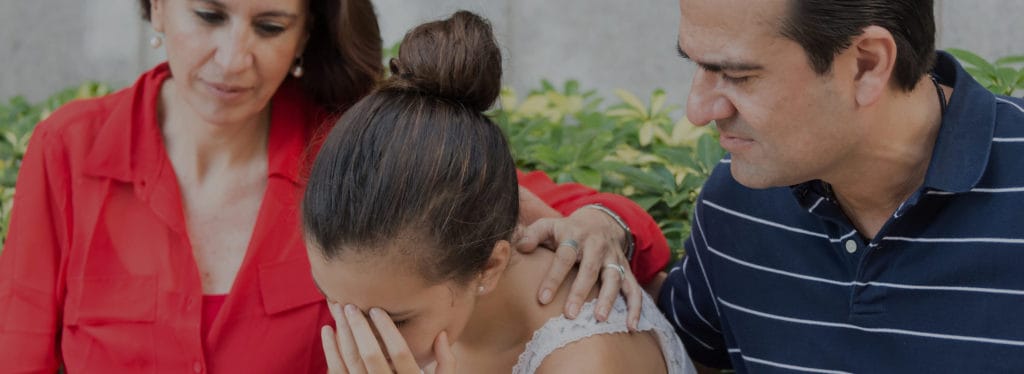
Truth From the Bible for Cutters: When Feelings for Self-Harm Are Strong
Self-harm is an attempt to find relief from emotional distress. Here is what the Bible offers parents to help their kids who are cutting.

When tweens and teens are experiencing psychological distress, they may cut themselves to cope with the emotional pain.
When life gets hard, sometimes kids harm themselves via cutting in order to express their psychological distress. Although it may be alarming to parents, a son or daughter’s cutting is a call for help and a way to cope with emotional pain.
Cutting usually involves making cuts on various parts of the body using razors, knives or shards of glass. (Other forms of self-harm include hitting one’s head against a wall, rubbing skin with erasers or burning one’s skin.) The relief obtained by harming oneself is a short-term attempt to cope with emotional pain. However, the feelings of relief can become addictive.
Many adults can’t understand why teens would harm themselves. However, cutting is a call for help to deal with unbearable hurt, anger and feelings of isolation and self-hatred. Self-injury gives some teens a temporary feeling of being in control when their world seems out of control. The pain is a reminder that they are still alive and provides a break from the emotional hurt. In addition, the physical wounds show healing whereas emotional pain lingers.
People engaged in self-injury are typically not trying to commit suicide, but the physical harm that results can be serious. Wounds may become infected, deep cuts can require stitches, and self-inflicted blows to the head may cause concussions.
Cutting isn’t a fringe phenomenon, unfortunately. About 2 million cases of cutting are reported each year, with many more cases unreported. Ask most high school students (and even many middle school kids) and they will tell you they know someone who is cutting to cope with emotional pain. In fact, a subculture of cutting flourishes on the Internet, with websites dedicated to providing guidance on how to cut “safely” or not get caught.
Although cutting is a call for help for relief from psychological distress, it is also an indicator of communication problems. Unable to verbalize and appropriately deal with their feelings, cutters adopt unhealthy means to cope with emotional pain and then have to deal with feelings of shame from their actions. You can reduce the likelihood your child will engage in cutting by:
When cutting is a call for help, you may see:
If you notice these signs in your child, start a conversation and remain calm—which is easier said than done. You could say something like, “I’ve noticed some scars on your arms. I love you, and I want to understand what you’re going through. Can you help me understand?” You could also ask questions, such as: “I’ve been hearing about cutting lately, and I was wondering if you know anyone who hurts themselves,” or “Have any of your friends at school been talking about cutting?”
Don’t downplay the issue as “a phase” or a simple “cry for help.” While those who cut typically do not intend suicide, research suggests that 70 percent of kids who engage in self-harm will make at least one suicide attempt.
Don’t demand that your child stop under threat of punishment or rejection, as this may just make the problem worse. Let your child know that you genuinely care and that she doesn’t have to cope with emotional pain by cutting. Do what you can to create an environment that encourages discussion.
Try to hold a glass of water with your arm extended for as long as you can. Does it get heavier the longer you hold it? Your muscles get tired and the glass feels heavier, even though the weight never changes. Emotional pain can feel the same way.
You can use this illustration to help your child understand the concept of letting things go. Identify trustworthy people in her life who can help her learn to release emotional pain in healthy ways. If your child doesn’t struggle with cutting, he can use this illustration to help a friend who does. He can show that emotional pain can become heavier over time. Furthermore, he can demonstrate the importance of finding healthy ways to cope with emotional pain.
This is a serious problem, and you should not try to address it alone. Seek help from a licensed mental health professional who has experience in this area. Some forms of counseling attempt to equip the teen with coping skills and articulate her feelings. She may also learn to tolerate stress more effectively. This may be the focus of therapy even before the actual cutting is addressed. The idea is that if you stop the cutting but your teen can’t cope with the emotional pain in a healthy way, self-harm is likely to recur.
You can help your child reach out to a teen who is cutting by equipping her with the right words to say. Your teen can communicate to her friend that she is not alone, that someone cares about her. She can also assure her friend that your teen is a safe person to talk to. Your child should also encourage someone who’s cutting to talk to a parent, school counselor or another trusted adult. Her friend may ask her to keep the cutting a secret, but some secrets keep others in danger. Let your teen know that to be a good friend, she needs to tell someone who can help.
Be a noticer
Be a builder
Becoming a connector
Copyright © 2019 by Focus on the Family





Dr. Daniel Huerta is Vice President of Parenting and Youth for Focus on the Family, overseeing the ministry’s initiatives that equip moms and dads with biblical principles and counsel for raising healthy, resilient children rooted in a thriving faith.
He is a psychologist, a licensed clinical social worker, and the author of 7 Traits of Effective Parenting. For many years, he has provided families with practical, biblically-based and research-based parenting advice on topics including media discernment, discipline, communication, mental health issues, conflict resolution, and healthy sexuality in the home. He is passionate about coming alongside parents as they raise contributors, instead of consumers, in a culture desperately in need of God’s kingdom.
Dr. Huerta has been interviewed by various media outlets including Fox News, Fatherly, Christianity Today, WORLD Magazine, and CBN, and he is a frequent guest on Christian radio stations across the nation. He’s also written for publications, including The Washington Post, on various topics related to marriage and parenting. He participated in the development of Focus on the Family’s Launch Into the Teen Years, a resource to help parents prepare their kids for adolescence, and he speaks regularly at retreats, conventions, and online events.
Dr. Huerta has maintained a private practice in Colorado Springs, Colorado since 2003 and has served families through Focus on the Family since 2004. He and his wife, Heather, have been married since 1997 and love being parents to their three teen children, Alex, Lexi, and Maci.

Self-harm is an attempt to find relief from emotional distress. Here is what the Bible offers parents to help their kids who are cutting.

When spouses stay alert to changes in each other, they can catch warning signs of possible mental health issues early on and seek the help they need.

A child or teen suicide attempt represents much more than a medical problem. It represents a young person in crisis, crying out for help.